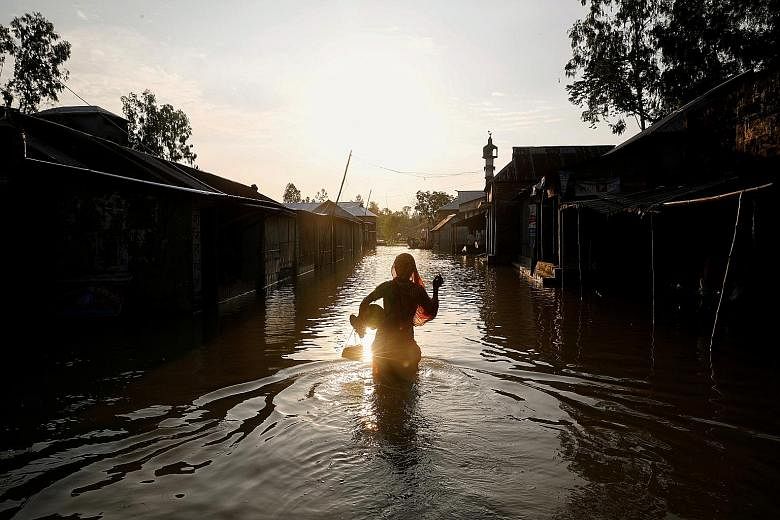DHAKA/NEW YORK • Torrential downpours have submerged at least one-quarter of Bangladesh, washing away the few things that count as assets for some of the world's poorest people - their goats and chickens, mud houses, sacks of rice stored for the lean season.
It is the latest calamity to strike the delta nation of 165 million people. Only two months ago, a cyclone pounded the country's south-west.
Along the coast, a rising sea has swallowed villages. And while it is too soon to ascertain what role climate change has played in these latest floods, Bangladesh is already witnessing a pattern of more severe and more frequent river flooding than in the past along the mighty Brahmaputra River, scientists say, and that is projected to worsen in the years ahead as climate change intensifies the rains.
"The suffering will go up," said Mr Sajedul Hasan, the humanitarian director of BRAC, an international development organisation based in Bangladesh that is distributing food, cash and liquid soap to displaced people.
This is one of the most striking inequities of the modern era. Those who are least responsible for polluting Earth's atmosphere are among those most hurt by its consequences. The average American is responsible for 33 times more planet-warming carbon dioxide than the average Bangladeshi.
This chasm has bedevilled diplomacy for a generation, and it is once again in stark relief as the coronavirus pandemic upends the global economy and threatens to push the world's most vulnerable people deeper into ruin.
An estimated 24 per cent to 37 per cent of the country's landmass is submerged, according to government estimates and satellite data. By Tuesday, according to the most recent figures available, nearly 1 million homes were inundated, affecting 4.7 million people. At least 54 have died, most of them children.
The current floods, which are a result of intense rains upstream on the Brahmaputra, could last through the middle of this month. Until then, Mr Taijul Islam, a 30-year-old sharecropper whose house has washed away, will have to camp out in a makeshift bamboo shelter on slightly higher ground.
At least he was able to salvage the tin sheet that was once the roof of his house. Without it, he said, his extended family of nine would be exposed to the elements.
His predicament is shared by the millions among those on the front lines of climate change globally.
The inequity is striking. One recent analysis has found that the world's richest 10 per cent are responsible for up to 40 per cent of global environmental damage, including climate change, while the poorest 10 per cent account for less than 5 per cent.
-
IMPACT OF FLOODS
-
1m
Number of homes inundated.
4.7m
Number of people affected.
54
Death toll.
Another estimated that warming had reduced incomes in the world's poorest countries by between 17 per cent and 30 per cent.
In Bangladesh, the floods began in June. Those who live along the Brahmaputra are no strangers to flooding. When the river starts swelling, work stops, the land erodes, people move to higher ground and wait for the waters to recede. They rely on their savings or aid to feed themselves.
This year was different. By the time the river flooded, in June, people were already running out of food, said Mr Hasan of BRAC.
Because of the lockdown, the people with jobs had all but stopped working. Remittances from relatives abroad, many of them newly unemployed, had dried up. In the countryside, people had begun to sell their goats and cattle at bargain prices. They had no food to eat.
The Brahmaputra is a fearsome, shape-shifting 3,840km river that erupts from the Tibetan Himalayas and spills into north-eastern India before merging with the Ganges in Bangladesh and emptying into the Bay of Bengal. Climate change, too, is altering the river's fate.
The rains have become more unpredictable and the river is rising above dangerous levels far more frequently than it did before, according to 35 years of flooding data analysed by Mr A.K.M. Saiful Islam, a water management expert at the Bangladesh University of Engineering and Technology in Dhaka.
Meanwhile, more and worse floods loom and no matter what, Mr Islam said, the country will have to adapt. That requires money to dredge rivers, maintain embankments, improve drainage and offer aid to those who are repeatedly displaced and impoverished.
"People are losing whatever little they have," said Ms Farah Kabir, the Bangladesh country director for ActionAid International, adding: "When and how are they going to be supported? When is the global community going to take responsibility?"
NYTIMES

